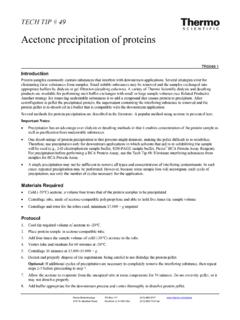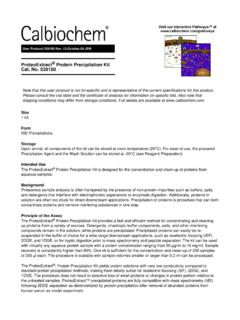Transcription of Optimization of protein extraction protocol for 2D PAGE ...
1 Romanian Biotechnological Letters , , 2012 Copyright 2012 University of Bucharest Printed in Romania. All rights reserved SHORT COMMUNICATION Romanian Biotechnological Letters, Vol. 17, No. 4, 2012 7529 Optimization of protein extraction protocol for 2D PAGE analysis of biofilm forming strain of Pseudomonas aeruginosa Received for publication, April 4, 2011 Accepted, February 15, 2012 VENKATESH CHATURVEDI 1,2*, ASHOK KUMAR1 1 School of Biotechnology, Banaras Hindu University, Varanasi, India-221 005 2 Department of Biotechnology, Guru Ghasidas Vishwavidyalaya, Bilaspur, Chattisgarh, India- 495009 Abstract In the present investigation, protein extraction protocol for biofilm forming strain of P.
2 Aeruginosa has been optimized. It was observed that conventional TCA/ acetone precipitation method was insufficient for 2D PAGE analysis. So, a slight modification in protein extraction protocol has been made to make it suitable for 2D PAGE analysis. This protocol appears to be suitable for 2D PAGE analysis of mucoid, biofilms forming strains. Keywords: 2D PAGE, IEF, Pseudomonas aeruginosa, Triton X-100, Biofilm. Introduction Pseudomonas aeruginosa is a ubiquitous and highly adaptable bacterium. It is also a leading opportunistic pathogen in human infections [1]. It has been reported that most of the strains belonging to P.
3 Aeruginosa form biofilms. Biofilms are clusters of microbial cells that are attached to a surface. It has been reported that bacteria experience shelter and homeostasis when residing inside a biofilms [2]. The biofilm matrix is a mixture of secreted polymers, absorbed nutrients and metabolites, cell lysis products and particulate material surrounding environment. Therefore, in a biofilm Exoployschharide (EPS), peptidoglycan, lipids, phospholipids proteins, polysaccharides, DNA and RNA can be observed [3]. The EPS matrix has the potential to physically prevent access of certain antimicrobial agents into the biofilm by acting as an ion exchanger, thereby restricting diffusion of compounds from the surrounding environment into the biofilm [4].
4 EPS has also been reported to capture metals, cations, and toxins [3]. EPS has also been reported to provide protection from a variety of environmental stresses, such as UV radiation, pH shifts, osmotic shock, and desiccation [2]. In the present study, a mucoid strain belonging to P. aeruginosa strain N1 (Accession No. HM627519) was isolated from a detergent contaminated pond situated in Varanasi city, India. This strain could metabolize Sodium dodecyl Sulfate as a source of carbon. Since SDS was metabolized by the bacterium and to the fact that SDS is toxic to the bacterium, it was anticipated that during growth of this bacterium with SDS.
5 A number of proteins, having potential role in SDS metabolism and also in defense against SDS stress would be expressed. So, it was important to study changes in P. aeruginosa proteome in response to SDS stress by 2D PAGE. However, it was observed that this bacterium formed biofilms, when grown in LB medium and in PBM medium in presence of SDS. The biofilms formed by this bacterium were very slimy and viscous. They interfered with centrifugation of the cell culture. When the culture was centrifuged, the cell pellet formed was very fluffy and it had a tendency to come at the surface of the medium. Also, the biofilms pellet was resistant to sonication. When the cells were sonicated, it was observed that the biofilms pellet did not disperse and it remained intact.
6 Anyhow, we made an attempt to optimize protein extraction protocol for 2D PAGE. VENKATESH CHATURVEDI, ASHOK KUMAR 7530 Romanian Biotechnological Letters, Vol. 17, No. 4, 2012 2D PAGE was performed according to Gorg et. al. [5]. The protein was isolated using conventional TCA/ acetone precipitation . Briefly, the cells were grown for overnight in 200 ml LB medium. After proper growth, the cell culture was vortexed for 2-3 times, to break the biofilms. The culture was centrifuged at 12000 rpm for 15 min at 4oC. The cell pellet was washed 2 times with 5 ml MilliQ water, in order to remove the cell debris. To the final cell pellet, ml of 10mM Tris-Cl pH- was added.
7 The pellet was vortexed. To the cell suspension 20mM DTT (Sigma, St. Louis, USA) and 1mM PMSF (Sigma, St. Louis, USA) was added. The cell suspension was sonicated at 5% Duty cycle and 50% Power output (Branson sonifier, USA) for 45 sec on and off for 8 -10 times. In between the cell suspension was placed in ice to dissipate the heat generated during sonication. Finally the cell suspension was centrifuged at 12000 rpm for 30 min at 4oC. The supernatant was transferred in a fresh centrifuge tube. To the supernatant 10% TCA (w/v) in acetone was added. The supernatant was placed at -20oC for 45 min for protein precipitation .
8 After precipitation , the solution was centrifuged at 12000 rpm for 30 min at 4oC. The protein pellet was washed 2 times with 90% acetone and was air dried. To the dried pellet, 500 l of Rehydration buffer [8 M urea, 2M Thiourea, 2% (w/v) CHAPS, (v/v) IPG buffer and (w/v) DTT] was added and the protein pellet was placed at 4oC for 8-10h with intermittent vortexing to solublize the protein pellet. The amount of protein was estimated by Bradfords test [6]. Appropriate amount of protein was applied to 13 cm long immobilized pH 3-10 NL gradient (IPG) strips (GE Healthcare). The IPG strips were rehydrated overnight with the solubilized proteins (250 l) at 20oC under mineral oil.
9 The strips were focused on Ettan IPGphor II (GE Healthcare). IEF was performed for a total of 52 kVh at 20oC. Focused strips were equilibrated in buffer [50 mM Tris/HCl, pH ; 6 M urea; 30% (v/v) glycerol; 2% (w/v) SDS; 1% (w/v) DTT] for 30 min then placed atop second dimension slab gels containing 12% acrylamide. Gels were electrophoresed with a broad-range molecular mass marker (Promega) at 20 mA per gel and stained with silver nitrate. The result is shown in figure 1A. Optimization of protein extraction protocol for 2D PAGE analysis of biofilm forming strain of Pseudomonas aeruginosa Romanian Biotechnological Letters, Vol. 17, No.
10 4, 2012 7531 Figure 1. 2D PAGE photograph of total cell proteins of P. aeruginosa strain N1. (A) Proteins extracted by cell sonication followed by TCA/ acetone precipitation . (B) Proteins isolated by our modified protein extraction protocol . It is clear from the gel photograph that only few isolated spots were visible. At acidic end of the strip, intense horizontal streaking and smearing was observed. It could not be resolved that whether this smearing was due to unfocussed proteins or it was due to presence of interfering substances in the crude protein extract. Literature survey suggests that horizontal streaking and smearing at basic end of the strip is caused by many factors.









